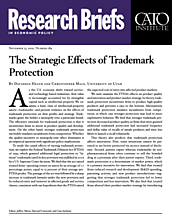As the U.S. economy shifts toward service- and technology-based industries, firm value is increasingly accounted for by intangible capital such as intellectual property. We examine a basic class of intellectual-property assets—trademarks—and present evidence on the effects of trademark protection on firm profits and strategy. Trademarks grant the holder a monopoly over a particular brand. The efficiency rationale for trademark protection is that it incentivizes firms to invest in product quality and development. On the other hand, stronger trademark protection inevitably insulates incumbents from competition. Whether the quality-incentive or monopoly-rent effect dominates is an empirical question with significant policy implications.
To study the causal effects of varying trademark protection, we exploit the Federal Trademark Dilution Act (FTDA) of 1995, which granted additional legal protection to “famous” trademarks until its key provision was nullified in 2003 by a U.S. Supreme Court decision. We find that the act raised treated firms’ operating return on assets by an average of 1.7 percentage points, equal to 12 percent of their average pre-FTDA profits. The passage of the act was followed by a sharp increase in trademark lawsuits under the new provision and by reduced entry and turnover in affected goods and service classes, consistent with our hypothesis that the FTDA raised the expected cost of entry into affected product markets.
We next examine the FTDA’s effects on product quality and innovation and product-market strategy. In theory, trademark protection incentivizes firms to produce high-quality products and prevents a race to the bottom. Alternatively, trademark protection insulates incumbents from competition, in which case stronger protection may lead to more exploitative behavior. We find that stronger trademark protection decreased product quality, as firms that were granted additional trademark protection had increased frequency and dollar value of recalls of unsafe products and were less likely to launch a recall voluntarily.
This theory also predicts that trademark protection affects innovation. First, some inventions cannot be patented or are better protected via secrecy instead of disclosure. Second, patents expire whereas trademarks do not: pharmaceutical firms often continue to sell the branded drug at a premium after their patent expires. Third, trademark protection is a determinant of market power, which is a primary incentive for innovation. We find that treated firms reduced research and development (R&D) spending, patenting activity, and new product introductions—suggesting that stronger trademark protection led to lower competition and less innovation. We also find that treated firms altered their product-market strategy by introducing brand-extending products in new product categories. At the same time, these firms created fewer new products in their legacy-product categories. Taken together, our results suggest that firms responded to stronger trademark protection by pursuing a more exploitative and less innovative product-market strategy, at the same time extending their brands into all-new product markets.
The main challenge for our research design is that the FTDA neglected to define the term “famous,” which has been previously decided in court on a case-by-case basis. Thus, there is no objective rule whether any given trademark qualifies as famous.
There are two aspects of our research design that help mitigate this problem. First, the key question for the FTDA’s effects on firm behavior is whether the firm and its competitors believed a trademark would qualify. Guided by the legal literature, we explore three independent approaches to assigning treatment status as of 1995 and find similar results for all three. Second, in our research design, mistakes in assigning treatment status attenuate the estimates of the law’s impact toward zero. With this caveat, our results can be seen as a lower bound on the law’s true effects.
Our analysis lets us identify the effects of the treatment on the treated—that is, the effects of granting additional antidilution protection to incumbent firms. Thus, our results do not speak directly to the effects of protection against infringement, which is the fundamental right associated with a trademark. However, our results are informative about changes to trademark policy at the margin in an environment (the United States) of strong intellectual-property enforcement. Interestingly, our results on product quality are consistent with those of economist Yi Qian in a very different setting: Qian finds that name-brand Chinese shoe companies responded to weaker protection against counterfeits by producing higher-quality products.
Our findings that the FTDA was followed by lower product quality and innovation add to recent studies on the potential downside of intellectual-property protection and suggest that strengthening trademark protection may not deliver what is promised on the label.
NOTE:
This research brief is based on Davidson Heath and Christopher Mace, “The Strategic Effects of Trademark Protection,” Review of Financial Studies (May 2, 2019), https://doi.org/10.1093/rfs/hhz084.
About the Authors
Davidson Heath and Christopher Mace, University of Utah

This work is licensed under a Creative Commons Attribution-NonCommercial-ShareAlike 4.0 International License.
